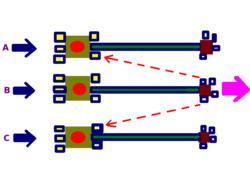Lateral inhibition
In neurobiology, lateral inhibition is the ability of an excited neuron to reduce the activity of its neighbors. It stops action potentials from spreading in the lateral direction. It is called lateral inhibition as it stops (inhibits) neighboring neurons from firing. This creates a contrast in stimulation. This increases perception. For example, in vision, it helps in differentiating edges. It occurs primarily in visual processes. But it has also been seen in tactile, auditory, and even olfactory processing.[1] Cells that use lateral inhibition are mainly present in cerebral cortex and thalamus. They make up lateral inhibitory networks (LINs).[2] Artificial sensory systems have artificial lateral inhibition built in them. Examples are vision chips,[3] hearing systems,[4] and optical mice.[5][6]
Lateral Inhibition Media
Optical illusion caused by lateral inhibition: the Hermann grid illusion
References
- ↑ Yantis, Steven (2014). Sensation and Perception. New York, NY: Worth Publishers. p. 77.
- ↑ Shamma, Shihab A. (3 January 1985). "Speech processing in the auditory system II: Lateral inhibition and the central processing of speech evoked activity in the auditory nerve". The Journal of the Acoustical Society of America. 78 (5): 1623. Bibcode:1985ASAJ...78.1622S. doi:10.1121/1.392800. PMID 3840813.
- ↑ Alireza Moini (2000). Vision Chips. Springer. ISBN 0-7923-8664-7.
- ↑ Artificial neural networks : ICANN 96 : 1996 international conference, Bochum, Germany, July 16-19, 1996 : proceedings. Berlin: Springer. 1996. ISBN 3-540-61510-5. OCLC 35029758.
- ↑ Alireza Moini (1997). "Vision Chips" (PDF).
- ↑ Richard F. Lyon (1981), "The Optical Mouse and an Architectural Methodology for Smart Digital Sensors" (PDF), Xerox PARC report VLSI-81-1

